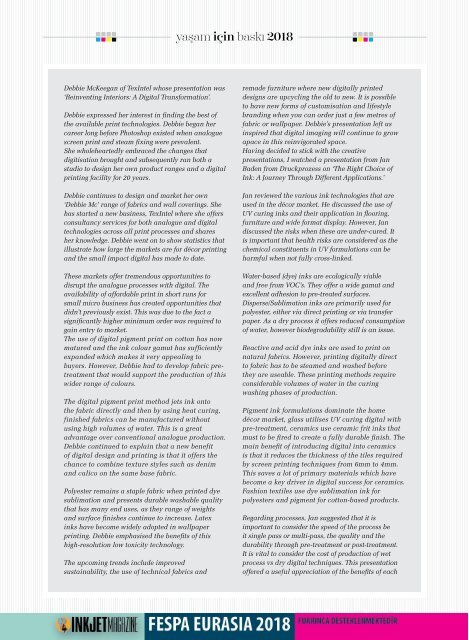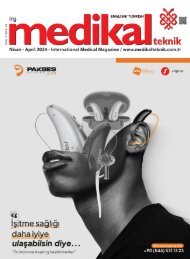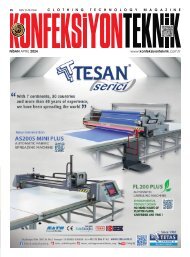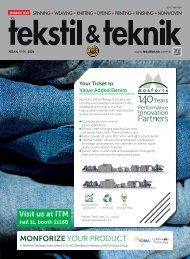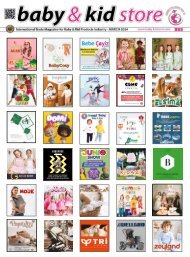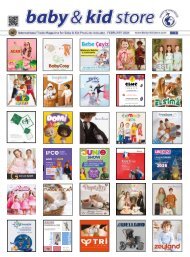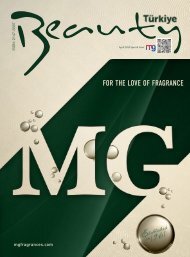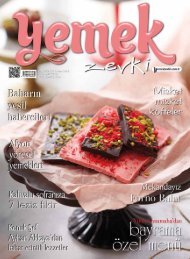Create successful ePaper yourself
Turn your PDF publications into a flip-book with our unique Google optimized e-Paper software.
yaşam için baskı <strong>2018</strong><br />
Debbie McKeegan of TexIntel whose presentation was<br />
‘Reinventing Interiors: A Digital Transformation’.<br />
Debbie expressed her interest in finding the best of<br />
the available print technologies. Debbie began her<br />
career long before Photoshop existed when analogue<br />
screen print and steam fixing were prevalent.<br />
She wholeheartedly embraced the changes that<br />
digitisation brought and subsequently ran both a<br />
studio to design her own product ranges and a digital<br />
printing facility for 20 years.<br />
Debbie continues to design and market her own<br />
‘Debbie Mc’ range of fabrics and wall coverings. She<br />
has started a new business, TexIntel where she offers<br />
consultancy services for both analogue and digital<br />
technologies across all print processes and shares<br />
her knowledge. Debbie went on to show statistics that<br />
illustrate how large the markets are for décor printing<br />
and the small impact digital has made to date.<br />
These markets offer tremendous opportunities to<br />
disrupt the analogue processes with digital. The<br />
availability of affordable print in short runs for<br />
small micro business has created opportunities that<br />
didn’t previously exist. This was due to the fact a<br />
significantly higher minimum order was required to<br />
gain entry to market.<br />
The use of digital pigment print on cotton has now<br />
matured and the ink colour gamut has sufficiently<br />
expanded which makes it very appealing to<br />
buyers. However, Debbie had to develop fabric pretreatment<br />
that would support the production of this<br />
wider range of colours.<br />
The digital pigment print method jets ink onto<br />
the fabric directly and then by using heat curing,<br />
finished fabrics can be manufactured without<br />
using high volumes of water. This is a great<br />
advantage over conventional analogue production.<br />
Debbie continued to explain that a new benefit<br />
of digital design and printing is that it offers the<br />
chance to combine texture styles such as denim<br />
and calico on the same base fabric.<br />
Polyester remains a staple fabric when printed dye<br />
sublimation and presents durable washable quality<br />
that has many end uses, as they range of weights<br />
and surface finishes continue to increase. Latex<br />
inks have become widely adopted in wallpaper<br />
printing. Debbie emphasised the benefits of this<br />
high-resolution low toxicity technology.<br />
The upcoming trends include improved<br />
sustainability, the use of technical fabrics and<br />
remade furniture where new digitally printed<br />
designs are upcycling the old to new. It is possible<br />
to have new forms of customisation and lifestyle<br />
branding when you can order just a few metres of<br />
fabric or wallpaper. Debbie’s presentation left us<br />
inspired that digital imaging will continue to grow<br />
apace in this reinvigorated space.<br />
Having decided to stick with the creative<br />
presentations, I watched a presentation from Jan<br />
Baden from Druckprozess on ‘The Right Choice of<br />
Ink: A Journey Through Different Applications.’<br />
Jan reviewed the various ink technologies that are<br />
used in the décor market. He discussed the use of<br />
UV curing inks and their application in flooring,<br />
furniture and wide format display. However, Jan<br />
discussed the risks when these are under-cured. It<br />
is important that health risks are considered as the<br />
chemical constituents in UV formulations can be<br />
harmful when not fully cross-linked.<br />
Water-based (dye) inks are ecologically viable<br />
and free from VOC’s. They offer a wide gamut and<br />
excellent adhesion to pre-treated surfaces.<br />
Disperse/Sublimation inks are primarily used for<br />
polyester, either via direct printing or via transfer<br />
paper. As a dry process it offers reduced consumption<br />
of water, however biodegradability still is an issue.<br />
Reactive and acid dye inks are used to print on<br />
natural fabrics. However, printing digitally direct<br />
to fabric has to be steamed and washed before<br />
they are useable. These printing methods require<br />
considerable volumes of water in the curing<br />
washing phases of production.<br />
Pigment ink formulations dominate the home<br />
décor market, glass utilises UV curing digital with<br />
pre-treatment, ceramics use ceramic frit inks that<br />
must to be fired to create a fully durable finish. The<br />
main benefit of introducing digital into ceramics<br />
is that it reduces the thickness of the tiles required<br />
by screen printing techniques from 6mm to 4mm.<br />
This saves a lot of primary materials which have<br />
become a key driver in digital success for ceramics.<br />
Fashion textiles use dye sublimation ink for<br />
polyesters and pigment for cotton-based products.<br />
Regarding processes, Jan suggested that it is<br />
important to consider the speed of the process be<br />
it single pass or multi-pass, the quality and the<br />
durability through pre-treatment or post-treatment.<br />
It is vital to consider the cost of production of wet<br />
process vs dry digital techniques. This presentation<br />
offered a useful appreciation of the benefits of each


